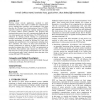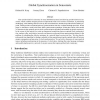216 search results - page 9 / 44 » Gradient clock synchronization in wireless sensor networks |
SENSYS
2004
ACM
14 years 1 months ago
2004
ACM
Wireless sensor network applications, similarly to other distributed systems, often require a scalable time synchronization service enabling data consistency and coordination. Thi...
AICT
2005
IEEE
14 years 1 months ago
2005
IEEE
Clock synchronization has paid a great magnitude of attention in the distributed systems. Sensor networks differ from traditional distributed system in many ways. One of the drama...
WICON
2010
13 years 5 months ago
2010
Clock skew is defined as the rate of deviation of a device clock from the true time. The frequency of a device's clock actually depends on its environment, such as the tempera...
LATIN
2004
Springer
14 years 29 days ago
2004
Springer
Time synchronization is necessary in many distributed systems, but achieving synchronization in sensornets, which combine stringent precision requirements with severe resource con...
EWSN
2006
Springer
14 years 7 months ago
2006
Springer
Time synchronization is a crucial component of a large class of sensor network applications, traditionally implemented as a standalone middleware service that provides a virtual gl...


